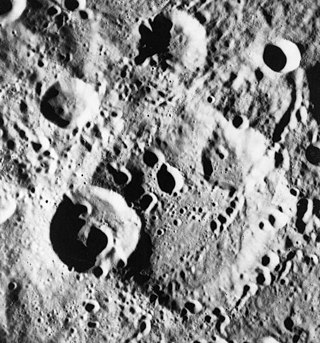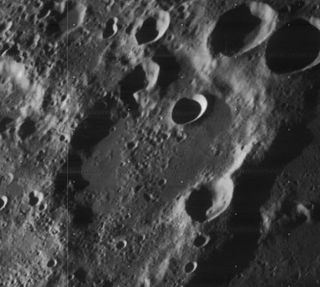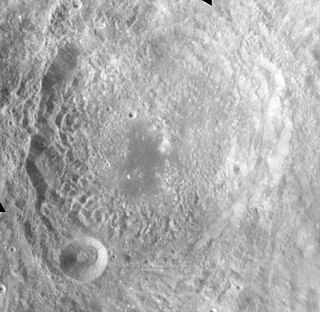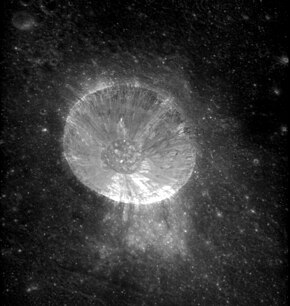
Zwicky is a lunar impact crater that is located on the far side of the Moon. It lies to the west of the crater Aitken, and is attached to the western rim of Vertregt. Attached to the northern end of Zwicky is Heaviside. Zwicky is a considerably eroded formation with an irregular rim and interior. Portions of the southern rim still survive, but the remainder has been almost completely eradicated.

Crile is a tiny lunar impact crater. It is roughly circular and cup-shaped, with interior walls that slope down to the midpoint. The crater lies in the Palus Somni, between the Mare Crisium to the east and Mare Tranquillitatis to the west.

Proclus is a young lunar impact crater located to the west of the Mare Crisium, on the east shore of the Palus Somni. Its diameter is 27 km. It was named after 5th century Greek mathematician, astronomer and philosopher Proclus.

Bilharz is a lunar impact crater that lies in the eastern part of the Mare Fecunditatis. It is the largest member of a close triple-crater formation with Atwood to the east and Naonobu to the northeast. To the southeast is the crater Langrenus.

Heaviside is a large lunar impact crater that is located on the far side of the Moon. It is attached to the eastern rim of the equally large walled plain Keeler, although Keeler is somewhat less eroded. To the northwest lies the crater Stratton, and to the southeast is the prominent Aitken.

Lyell is a lunar impact crater that lies along the eastern edge of the Mare Tranquillitatis, at the northern arm of the bay designated Sinus Concordiae. It was named after Scottish geologist Charles Lyell. To the north along the edge of the lunar mare is the crater Franz. The region of terrain to the east of Lyell is named Palus Somni.

Glaisher is a lunar impact crater that is located in the region of terrain that forms the southwest border of Mare Crisium. It lies to the southwest of the lava-flooded crater Yerkes, and west-northwest of the Greaves–Lick crater pair. It is surrounded by a ring of satellite craters of various dimensions, the larger companions generally being arranged to the south of Glaisher.

Zhiritskiy is a lunar impact crater that is located on the far side of the Moon. It lies to the south of the large walled plain Fermi, and northwest of the crater Schaeberle.

Gilbert is a large lunar impact crater that lies near the eastern limb of the Moon. Due to its location this feature appears foreshortened when viewed from the Earth, limiting the amount of detail that can be observed. The crater lies to the northwest of the similar-sized walled plain Kästner, to the west of the Mare Smythii.

Kästner is a lunar impact crater that is located near the eastern limb of the Moon, to the southwest of the Mare Smythii. Just to the northwest of Kästner is the walled plain Gilbert. To the south is the prominent crater Ansgarius, and to the southwest lies La Pérouse.

La Pérouse is a lunar impact crater that is located near the eastern limb of the Moon. It lies northwest of the larger crater Ansgarius, and to the east of Kapteyn. This crater appears foreshortened due to its location, but the rim is nearly circular when viewed from orbit.

Mons Hadley is a massif in the northern portion of the Montes Apenninus, a range in the northern hemisphere of the Moon. It has a height of 4.5 km (2.8 mi) 14,764 ft (4,500 m) above the adjacent plain and a maximum diameter of 25 km at the base.

Ibn Firnas is a lunar impact crater on the far side of the Moon. Attached to the exterior of its southwestern rim is the prominent crater King. Only a few kilometers to the north, separated by a rugged stretch of terrain, is the larger crater Ostwald.

Danjon is a lunar impact crater on the far side of the Moon. It lies less than a crater diameter to the east-southeast of the larger crater Langemak. To the east-northeast of Danjon is the crater Perepelkin, and due south lies the walled plain Fermi.

D'Arsonval is a small lunar impact crater on the far side of the Moon. It is situated across the northeastern rim of the older and larger crater Danjon. To the west of D'Arsonval is Perepelkin.

Delporte is a lunar impact crater on the far side of the Moon. It overlies part of the northwestern rim of the huge walled plain Fermi, and the crater Litke is nearly attached to the southeastern rim.

Dobrovolʹskiy is a small lunar impact crater on the Moon's far side. The northwest part of its rim is intruded upon by the somewhat larger crater Shirakatsi, and the outer rampart of that feature covers most of the interior floor of Dobrovolʹskiy. Very little of the original floor now survives, with a small section near the southern inner wall. The remainder of the crater rim is somewhat circular and only mildly worn.

Neujmin is a lunar impact crater on the Moon's far side. It is nearly attached to the west-southwest of the smaller crater Waterman, and lies to the southwest of the prominent Tsiolkovskiy.

Langemak is a prominent impact crater on the far side of the Moon. It is located less than one crater diameter west-northwest of Danjon, and nearly due east of Meitner. To the southwest of Langemak is Kondratyuk. Langemak partly overlies the larger and older crater Langemak N. This feature is also attached to the northeastern rim of Kondratyuk.

Rupes Cauchy is a 120 km-long escarpment at 9.0°N 37.0°E on the surface of the Moon. It faces southwest, and rises about 200–300 m. It is located in the northeastern portion of the Mare Tranquillitatis, and is named after the nearby crater Cauchy.























